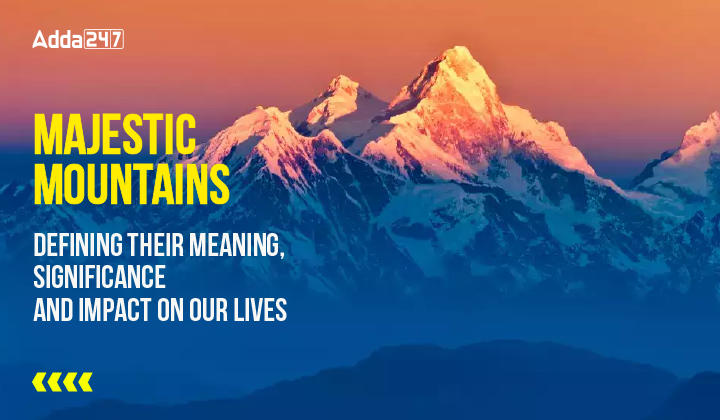Table of Contents
Mountains, these towering landforms that rise dramatically above the earth’s surface, have long captured the human imagination and inspired fascination. They stand as timeless symbols of strength, resilience, and breathtaking beauty. Throughout history, mountains have been revered in ancient folklore as the abodes of gods and mystical beings, while also serving as a source of inspiration for artists and adventurers alike. In this article, we will explore mountains that cover over 25% of the earth’s surface and provide habitat for more than 85% of the world’s bird, amphibian, and mammal species.
Meaning and Definition of Mountains
A mountain is generally defined as a natural landform that rises significantly above the surrounding landscape. The United States Geological Survey (USGS) classifies a mountain as having a minimum elevation of 1,000 feet (304.8 meters) above sea level, though this threshold can vary among different countries and organizations. It’s essential to recognize that mountains come in a wide range of sizes, shapes, and geological origins, from towering peaks like Mount Everest to more modest hills and small mountains in less rugged areas.
Mountains and hills are formed by the movement of tectonic plates beneath the Earth’s surface. There are various types of landforms, including mountains, hills, plateaus, and plains, each playing a vital role in influencing different biological and social factors. This article provides detailed insights into mountainous landforms, their significance, and their impact on our lives.
Formation of Mountains
Mountains are created through a geological process called orogeny. Orogeny refers to the process of mountain formation, which occurs due to the movement and interaction of tectonic plates that make up the Earth’s lithosphere (the outermost layer of the Earth). There are various ways mountains can form, with the most common types including:
- Fold Mountains: Formed when tectonic plates collide and compress the Earth’s crust, causing rock layers to buckle and fold. This process creates mountain ranges with parallel ridges and valleys. Examples include the Himalayas in Asia and the Andes in South America.
- Fault-Block Mountains: Created when blocks of crust are uplifted along large faults or fractures, resulting in mountain ranges with steep, rugged slopes on one side and gentler slopes on the other. The Sierra Nevada in the United States is an example.
- Volcanic Mountains: Formed by the accumulation of lava, ash, and volcanic materials from eruptions. As magma rises to the surface and builds up, it creates a volcanic mountain. Examples include Mount St. Helens in the United States and Mount Fuji in Japan.
- Dome Mountains: Created when molten rock (magma) forces its way beneath the Earth’s crust, causing the overlying rocks to arch upward into a dome shape. Erosion may expose the hardened magma at the dome’s center. An example is the Black Hills in South Dakota, USA.
- Plateau Mountains: Large, flat-topped mountains formed by the uplift of a broad region. Erosion over time leaves a flat summit with steep sides. The Colorado Plateau in the USA is an example.
Ecological Significance and Impact of Mountains
Mountains have a crucial place in making Earth a lively planet. Following are the points highlighting their ecological importance:
-
Biodiversity Hotspots: Mountains are often biodiversity hotspots, harbouring a wide range of flora and fauna, some of which are unique and found nowhere else on Earth. These diverse ecosystems provide essential habitats for numerous plant and animal species, contributing to global biodiversity.
-
Water Towers of the World: Mountains act as water towers, capturing and storing precipitation in the form of snow and glaciers. As the snow melts, it feeds streams and rivers, providing a vital source of freshwater for millions of people downstream, supporting agriculture, industries, and ecosystems.
-
Climate Regulation: The presence of mountains influences local and regional climates. They affect temperature, precipitation patterns, and wind patterns, contributing to the creation of distinct microclimates and influencing weather systems in adjacent areas.
Sociological Significance and Impact of Mountains
Mountains as landforms have affected society and life of human beings at large. Following are the points highlighting the sociological significance of mountains:
-
Cultural Heritage and Traditions: For indigenous communities, mountains are often central to their cultural identity and beliefs. These majestic landscapes are integral to their myths, rituals, and traditional practices, passing down their knowledge through generations.
-
Tourism and Recreation: Mountains attract millions of tourists each year, seeking adventure, recreation, and a connection with nature. Activities like hiking, skiing, mountaineering, and mountain biking not only provide economic opportunities for local communities but also promote physical and mental well-being for visitors.
-
Economic Resources: Mountains are abundant sources of various natural resources, including minerals, timber, and medicinal plants. Responsible and sustainable management of these resources is crucial to maintain ecological balance and support local economies.
-
Geological and Scientific Interest: Studying mountains and their geological formations provides valuable insights into the Earth’s history and evolution. They reveal information about plate tectonics, rock formations, and the processes that shaped our planet.
-
Watershed Management: Mountains are often the source of major watersheds, where rainfall and snowmelt accumulate and flow into rivers and streams. Proper management of these watersheds is crucial for maintaining water availability and quality downstream.
-
Natural Barriers: Mountains can act as natural barriers, protecting certain regions from extreme weather events, such as hurricanes and typhoons, and controlling the spread of desertification.
- Earth’s Beauty and Aesthetics: Mountains are awe-inspiring and contribute to the beauty of the natural landscape. They have inspired artists, writers, and photographers for centuries.
Challenges of Mountain Conservation
-
Environmental Threats: Mountains face several environmental challenges, including deforestation, habitat destruction, and climate change. Melting glaciers and altered precipitation patterns can lead to water scarcity and impact downstream communities.
-
Cultural Erosion: With modernization and globalisation, traditional mountain cultures and knowledge are at risk of being eroded, threatening the invaluable intangible heritage of indigenous mountain communities.
Conclusion
Mountains are more than just geological formations; they carry deep meaning and significance in human life. As symbols of spirituality, resilience, and natural beauty, they inspire us to explore both our inner selves and the world around us. Their ecological value as biodiversity hotspots and sources of water highlights their crucial role in supporting life on Earth. Despite their grandeur and importance, mountains face many challenges that demand immediate conservation efforts.
Let us appreciate the majesty of mountains and recognize their impact on our lives. By protecting these ancient giants, we ensure that future generations will continue to be inspired and connected to the awe-inspiring wonders that have influenced human culture and history for thousands of years. So, the next time you admire a mountain, take a moment to reflect on its profound significance and the essential role it plays in the complex web of life.
DSSSB EVS Study Notes PDF
Candidates preparing for the DSSSB Exam must check out the DSSSB EVS Study Notes PDF Link for easy access to study material on Mountains Topic under the DSSSB EVS Section.




 UP TGT Sanskrit Syllabus and Exam Patter...
UP TGT Sanskrit Syllabus and Exam Patter...
 UGC NET Study Notes for Paper 1, Downloa...
UGC NET Study Notes for Paper 1, Downloa...
 Bloom Taxonomy, Purpose, Domains, Exampl...
Bloom Taxonomy, Purpose, Domains, Exampl...




